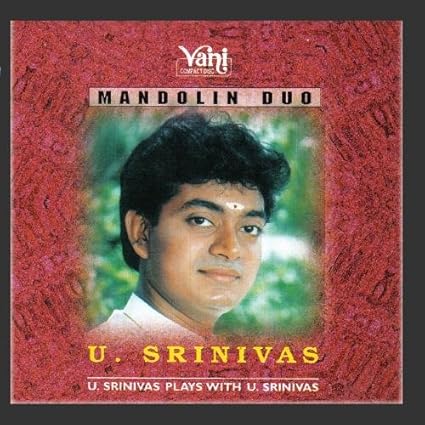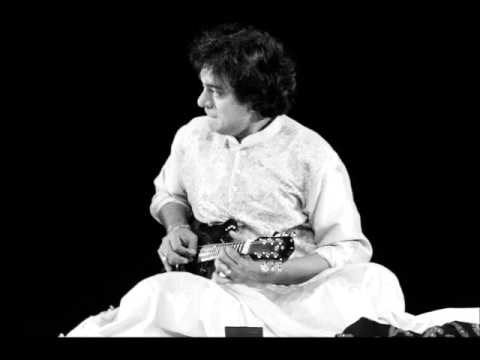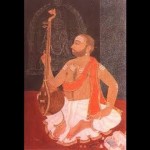Sometimes the life and music of a great talent is as brief and brilliant as the melodies they play. One such meteor in the music world, passed all too quickly and very recently.
Better known as Mandolin Srinivas, the feature of the next installment of our continuing Series on Andhra Personalities came to be identified with and by the very instrument itself.
Background

Srinivas Uppalapu was born in Palakol village, West Godavari district, Andhra Pradesh in the year 1969. As a testament to the innate genius of this musician, he picked up the mandolin on his own, as a child. In fact, his first guru was his father, who did not know how to play. While his father would sing, Srinivas would accompany him on his broken mandolin–truly a case of “embodied knowing” if there ever was one. At the age of five “the young boy started played Viribhoni varnam in three tempos without knowing the notation.” [1]
At that time, however, many musicians were skeptical about whether Carnatic music could be played on the mandolin because they believed that sustained and oscillatory notes (Gamakas), which are an integral part of Carnatic music, could not be produced on a mandolin.Young Shrinivas was determined to prove them wrong, and he played pure ragas like Bhairavi, Khamboji, Varaali, Kalyani and Pantuvaraali entirely by ear and showed that it was possible to play these ragas on the mandolin. [1]
Nevertheless, young Srinivas would finally gain formal training courtesy Rudraraju Subbaraju, who was a disciple of Chembai Vaidyanatha Bhagavathar. At the age of 12, Srinivas gave his first major performance at the Indian Fine Arts Society, Chennai. Technically, though, his first ever Carnatic peformance was at the tender age of 9, during the Thyagaraja Aradhana, no less.
What is rare, and even unique, about Srinivas gaaru is that the Mandolin is not a traditional Carnatic instrument. Purists naturally balk at such a notion, but as the violin has been adapted to suit the Carnatic tradition and tastes, so too did the man who became most associated with the mandolin, manage to incorporate it as well. While the jury may still be out on the fashion to create fusion music with Carnatic, he managed to show that the tradition has the potential to adapt to the times and changing tastes. In an interview of him (along with his younger brother U.Rajesh, also a mandolin virtuoso), the Carnatic musician and composer said the following:
Now where does Carnatic music stand? “It’s the basis. It is like the Sanskrit language, from which springs so many other languages. Carnatic music is here to stay with us and all other music that we play is based on that” [6]
While his later life was characterised by a difficult marriage, he tragically passed away from liver problems irrespective of reputedly never drinking or smoking. His legacy, nevertheless, lives on today in his son. A rare talent who, despite having the spark of a Gandharva attested to by all, remained soft-spoken and humble in the wake of musical genius. Tamil Nadu deserves full credit for giving him patronage, a failure of Andhra among a long line of other unsupported Telugu artistic talents gone unsung. It is one that we would do well to remember, as it had no small part in Sri Uppalapu Srinivas later being referred to as Mandolin “Srinivasan“.
Achievements

All the greats of Tamil Nadu feted this fantastic embodiment of Gandharva Veda. From Smt. M.S.Subbulakshmi to the TN Chief Minister MGR, this Telugu boy was the toast of the Tamil country. As his repertoire and fame expended, so to did his retinue and professional relationships.
Apart from his Carnatic concerts, Srinivas also collaborated with western and Indian classical musicians for fusion music performances. He collaborated with Indian musicians such as Zakir Hussain, V Selvaganesh, and Shankar Mahadevan as well as international artistes like guitarist John McLaughlin. [2]
As a matter of fact, the latter had mentioned who all these greats were part of an aptly named Shakti music group. While they would all collaborate with him, Srinivas was a talent who could stand on his own accomplishments, of which there were many.
- First public performance at age 9, in Kudivada, Andhra Pradesh
- Experimented and built his own 4 string Mandolin (later 5) from traditional 8
- Recorded over 40 Albums and composed original music along with his brother
- Performed around the world at concerts featuringJazz & W. Classical Orchestras
- Founded the Shrinivas Institute of World Music
- Revived many forgotten Ragas in the Bharatiya Saastriya Sangeeta tradition [5]
- Titled the Asthana Vidvan of Tamil Nadu by the State Govt. in 1984
- Mysore T. Chowdiah Memorial National Award (1992)
- Received the Padma Shri in 1998
- Won the Sangeet Natak Academy Award in 2010
- Nominated for the Padma Bhushan

Legacy
Srinivas gaaru’s passing in 2014 was mourned the world over. The Hindu printed a full page collection of articles to remember him.
A “prodigy”, a “trailblazer”, a “rebel”, Uppalapu Srinivas was known by many names, but above all, the name of the instrument for which he was most famous.
Better known as Mandolin Srinivas, this week’s Andhra Personality was not only a virtuoso of music, but a teacher as well, giving lessons free of cost to many. Described as a musician born once in many centuries, inheritor of a divine musicality, and a true Gandharva in the tradition of Gandharva Veda, he left us all too soon.
In fact, for a while in Carnatic music circles, many were even referring to him as Mandolin SrinivasAN. This is once again testament to how poorly Telugus have given patronage to their own high culture Talent. This realisation is not just one in sangeeta circles, but also sincerely being recognised by leaders in the business community . This is a failing of not just the elites, but the mamidi manishi as well, who has spent the better part of the last decade more interested in bolly-tolly trash that gives a tawdry beat than music that uplifts the spirit with melody. Whether artistic or political or business or common man, it’s imperative to keep the culture alive by giving due recognition and support to the Telugu community’s own up-and-coming artistes and talented trailblazers. Mandolin Srinivas is one such star who blazed an all too brief, but brilliant trail.
So let us remember him for his contributions to music as well as for his advocacy of tradition in words best spoken by Mandolin Srinivas himself:
Karnatik music, in fact, I would say Indian classical music, is a system with tremendous potential, and an amazing training ground. Once a person is well-groomed in it, he/she are equipped to match any other music system in the world. I attribute the success of my jugalbandis with Hindustani music and collaborations with world-music performers to the fact that I have a Karnatik music base.
It is the potency of our classical music which has qualified me to occupy the same stage as other world greats. [3]
References:
- http://www.mandolinshrinivas.com/
- http://timesofindia.indiatimes.com/india/Mandolin-U-Srinivas-a-rebel-who-silenced-his-critics-with-music/articleshow/42892114.cms
- http://www.deccanherald.com/content/116234/F
- http://timesofindia.indiatimes.com/home/sunday-times/all-that-matters/Shrinivas-was-the-spirit-of-Shakti-who-can-replace-him-John-McLaughlin/articleshow/43045691.cms?
- http://www.dnaindia.com/mumbai/report-u-srinivas-and-the-mandolin-falls-silent-2020025
- http://www.thehindu.com/features/friday-review/music/mandolin-magic/article598029.ece
- http://www.nytimes.com/2014/10/01/arts/music/u-shrinivas-indian-mandolin-virtuoso-dies-at-45-.html?_r=1







